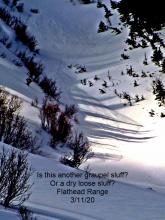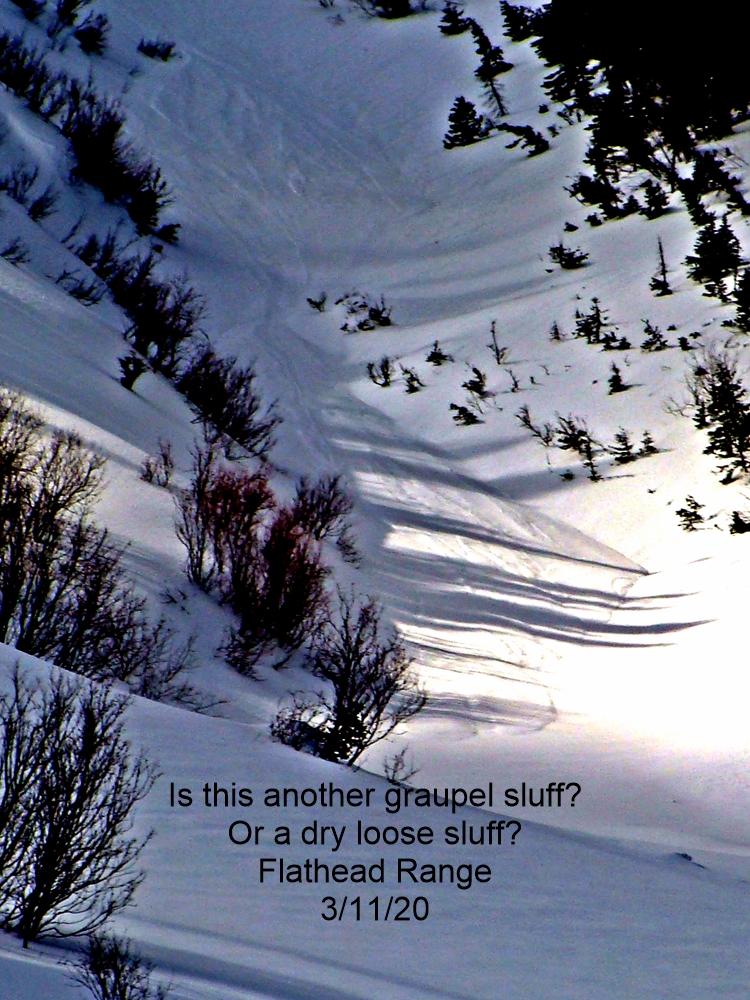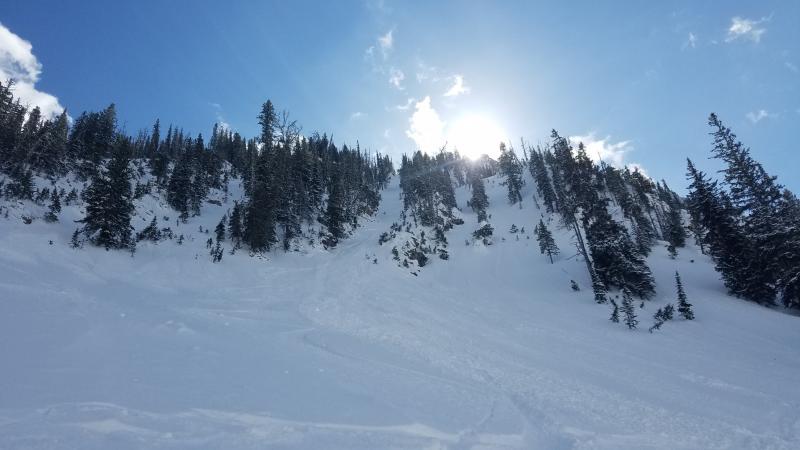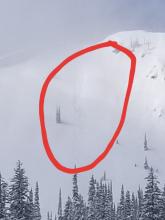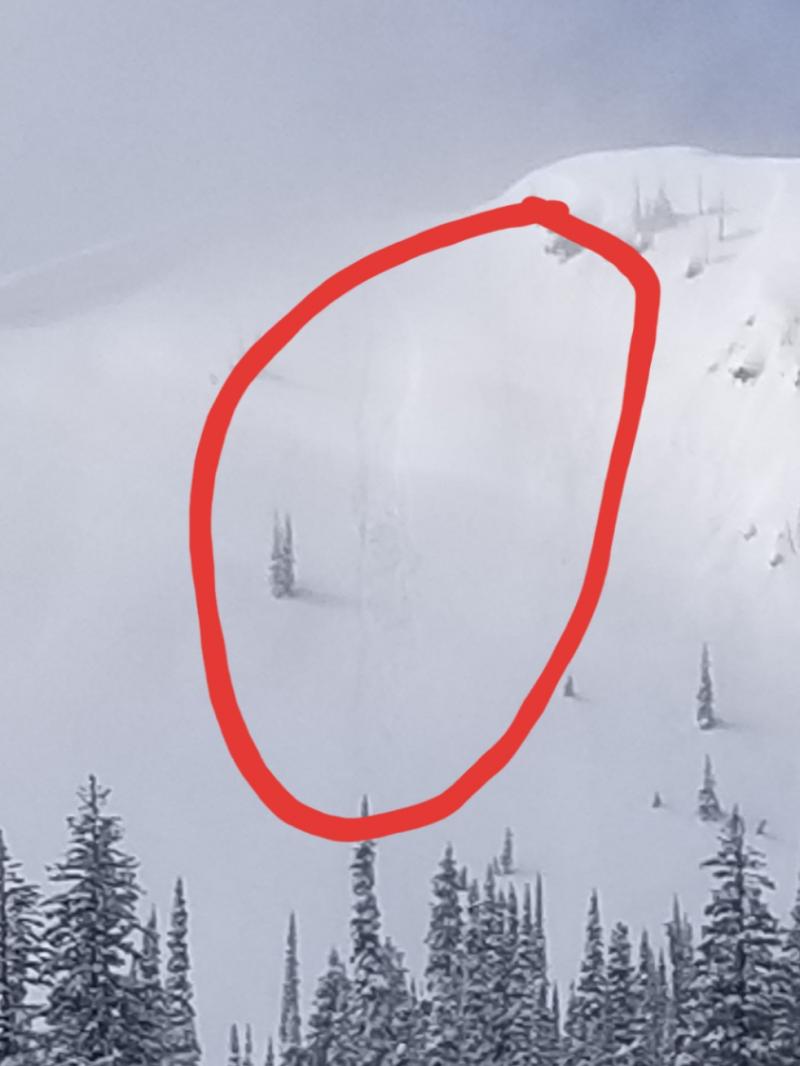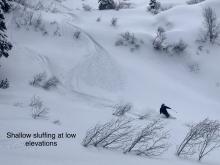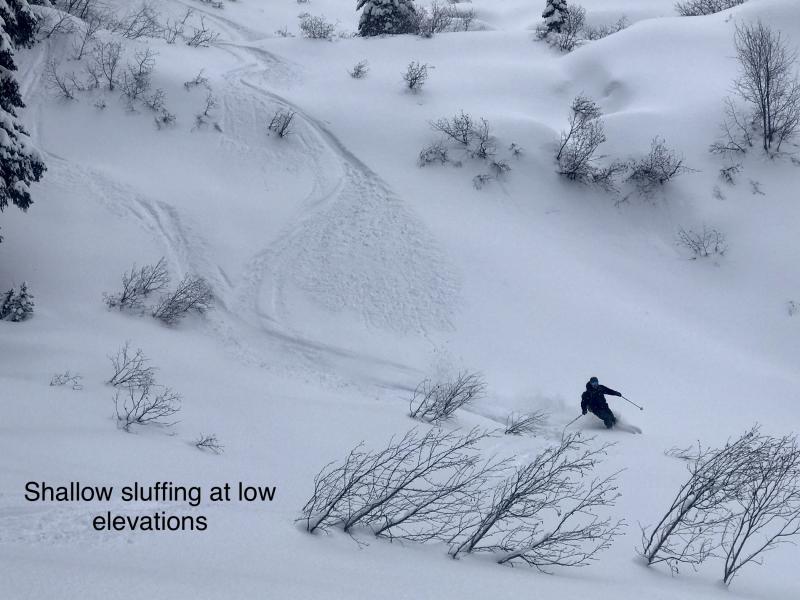| Tuesday | Tuesday Night | Wednesday | |
|---|---|---|---|
| Cloud Cover: | Snow showers. | Snow showers ending. | High pressure building |
| Temperatures: | 20-30 deg. F. | 11-18 deg. F. | 22-31 deg. F. |
| Wind Direction: | SW | W | SW |
| Wind Speed: | 5-7 | 5-7 | 6-10 gusts 23 |
| Snowfall: | 1-4 in. | 0-1 in. | 0 in. |
| Snow Line: |
Whitefish Range
Flathead Range and Glacier National Park
How to read the forecast
Wind speeds and precipitation have moderated over the past 2 days, but the recently drifted snow needs a chance to settle and strengthen. The avalanche danger is MODERATE above 5000 feet. Human triggered avalanches are possible, especially in wind loaded areas. The avalanche danger is LOW below 5000 feet. Isolated areas with reactive persistent slabs and lingering storm instabilities warrant careful snowpack evaluation and conservative terrain choices.

2. Moderate
?
Above 6500 ft.
2. Moderate
?
5000-6500 ft.
1. Low
?
3500-5000 ft.
- 1. Low
- 2. Moderate
- 3. Considerable
- 4. High
- 5. Extreme
-
Type ?
-
Aspect/Elevation ?
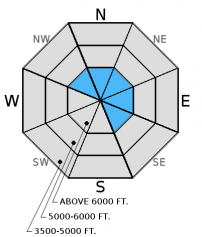
-
Likelihood ?CertainVery LikelyLikelyPossible
 Unlikely
Unlikely -
Size ?HistoricVery LargeLargeSmall

We have limited data from the true alpine terrain of our forecast area. Unfortunatey, these are the areas where wind slabs have been building over the past week. Windslabs in these areas have increased in size and thickness and can easily be 2-3 feet thick. Cross loaded slopes have also developed thick wind slabs as Guy and Erich found yesterday (video). Windslabs can take up to a week to gain strength. In some areas expect to find fresh windslabs 2-3 feet thick that will remain sensitive to human triggers. Wind loaded slopes are easy to identify. Look for smooth, rounded features and convex pillows on leeward slopes. Carefully evaluate wind loaded terrain before committing to a slope.
-
Type ?
-
Aspect/Elevation ?

-
Likelihood ?CertainVery LikelyLikelyPossible
 Unlikely
Unlikely -
Size ?HistoricVery LargeLargeSmall

Persistent slabs including those sitting on weak snow below the January 12 rain crust and around the January 17 rain crust are getting more difficult to affect in stability tests that suggests that they are gaining strength. But in some areas they continue to fracture and propagate in these tests illustrating that it is still possible to trigger an avalanche on these layers. BNSF avalanche safety noted clean Q1 shears in tests performed yesterday. The failure layer was on top of a melt freeze crust 30 inches below the snow surface (video). As these layers get buried deeper and the probability of triggering an avalanche on one of them lowers the consequence remains severe. The only way to know if these layers are present and reactive is to dig into the snow and perform stability tests. Where these weak layers exist consider how you may trigger them like in areas with shallow snow where they are closer to the surface, and in steep, rocky terrain. A rapid stress to these layers like cornice fall, smaller avalanches, or multiple machines on a slope could also awaken them.
-
Type ?
-
Aspect/Elevation ?
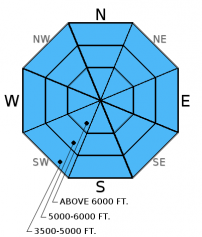
-
Likelihood ?CertainVery LikelyLikelyPossible
 Unlikely
Unlikely -
Size ?HistoricVery LargeLargeSmall

In many locations recent low density snow was deposited onto a rain crust. This snow has not bonded well to the crust and loose snow avalanches may still be triggered in steep terrain. These avalanches could entrain a lot of snow and pack a big punch. Remember that even small avalanches can have severe consequences if you are caught while traveling in or around terrain traps like narrow gullies, trees, or cliffs.
Though not wide spread across the advisory area, there are locations where large cornices have been observed (and failed). If you encounter large cornices give them a wide buffer as they are likely recently formed and sensitive. Remember that cornices can pull out behind the ridgeline and take you with them. Aside from the danger of being hit by a large mass of consolidated snow they are the "bombs of the backcountry" and can trigger deep and dangerous avalanches.
The final report for the 1/23/2016 avalanche fatality in Swede Creek in the Whitefish Range is complete and located here: http://www.flatheadavalanche.org/sites/default/files/20160124_swedecreekavalaccidentreport_final.pdf.
Yesterday, I traveled to Wahoo Creek in the Flathead Range. We found low density surface snow that was not adhering well to a rain crust formed January 28 (observation).
Erich and Guy went to the northern Mission Mountains yesterday (outside of our advisory area). On their snowmobile tour they found evidence of recent crossloading (photo, video, observation).
Also on Monday, BNSF avalanche safety reported Q1 shears with hard force in their stability tests. The failure layer was facets/decomposing surface hoar resting on a melt freeze crust buried approximatley 30 inches below the snow surface (video, observation). Skiers in Rescue Creek in the Flathead Range noted evidence of avalanche debris covered by recent snowfall.
A skier triggered avalanche was reported in Noisy Basin in the Swan Range Sunday. There were no other details, but no one was caught.
Also on Sunday, a party of snowbikers and snowmobilers were in McGinnis Creek in the southern Whitefish Range and triggered a small windslab (observation). Skiers in the Ghoulie Point area in the southern Whitefish Range dug a snow pit and found a crust buried buried 20 inches deep with weak, faceted snow on top. Stability tests produced fractures on top of this crust that did not propagate and fractures below the recent storm snow (observation).
Saturday, snowmobilers reported natural avalanche activity in McGinnis Creek in southern Whitefish Range.
Guy and I were in the Skyland area in the Flathead Range Saturday. We observed a recent natural avalanche thought to be a wind slab triggered by loose snow (photo). He noted wind drifting the snow on the ridgelines, as well as mid slope level.
BNSF Avalanche Safety reported a large cornice failure in their program area that occured on January 29. The debris slid an estimated 800 vertical feet (photo *observed 1/30).
For more information on the recent avalanche fatality in Swede Creek, Whitefish Range (1/23/2016) please view the final report here.
Visit our Observations page and our You Tube channel for more observations from the entire season.
Thanks to everyone for submitting observations. They are extremely useful and could help save lives.
HOW TO SUBMIT OBSERVATIONS:
Email: [email protected]
Call and leave a message: 406.387.3821
You can also submit quick observations via text: 406.241.4571 (FAC mobile)
OR
Submit Snowpack Observations: http://www.flatheadavalanche.org/node/add/snowobs
Submit Avalanche Observations: http://www.flatheadavalanche.org/node/add/avyobs
After a benign weather day of partial clearing and light winds, snow showers redeveloped yesterday afternoon and into the evening. Surprise Surprise...the most notable snowfall was in the Swan Range where Noisy Basin SNOTEL recorded 6 inches in the past 24 hours. Light winds blew out of the west and southwest. Currently, temperatures range from 13º-20º F, and winds are 1-10 mph out of the west-southwest. Today temperatures will rise to the low to mid 20s. Winds will continue out of the west-southwest at 5-10 mph. Snow shower redevelopment is expected today with 2-5 inches of new snow expected.
| 0600 temperature: | 13-20 deg. F. |
| Max. temperature in the last 24 hours: | 18-26 deg. F. |
| Average wind direction during the last 24 hours: | W-SW |
| Average wind speed during the last 24 hours: | 3-18 mph |
| Maximum wind gust in the last 24 hours: | 5-24 mph |
| New snowfall in the last 24 hours: | 0-6 inches |
| Total snow depth: | 69-100 inches |
This advisory applies only to backcountry areas outside established ski area boundaries. This advisory describes general avalanche conditions and local variations always occur. This advisory expires at midnight on the posted day unless otherwise noted. The information in this advisory is provided by the USDA Forest Service who is solely responsible for its content.

























